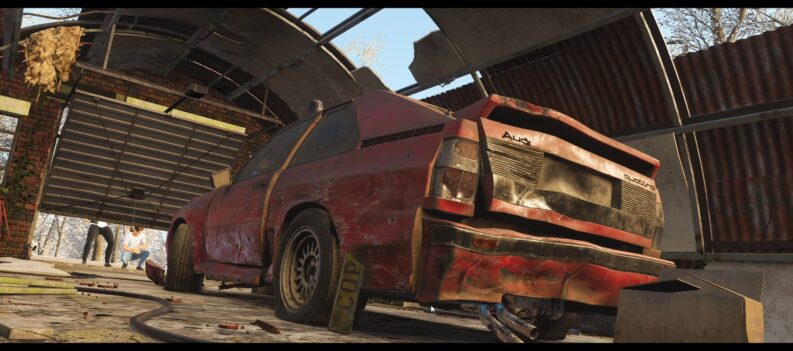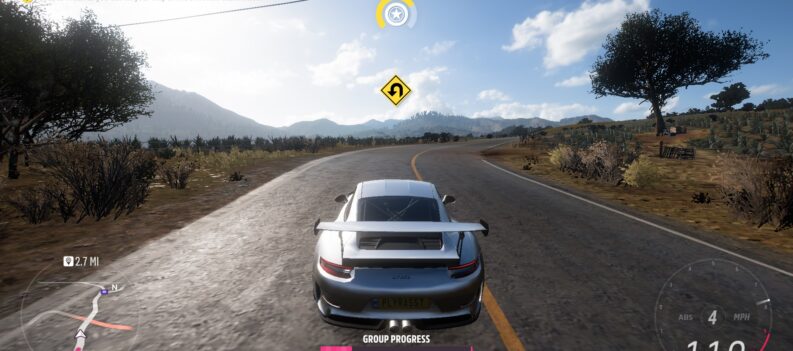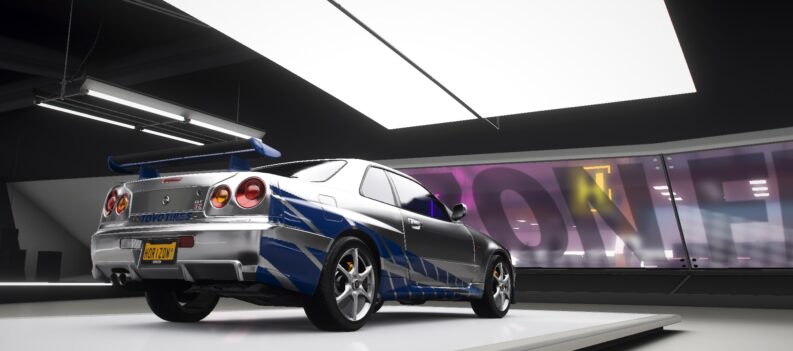Forza Horizon 4 gives players the ability to enhance the engine performance, sound, chassis handling capabilities, and grip of in-game cars through the tuning menu.

Many new players in the racing game genre may not know exactly how and what these upgrades do to their car, so that is what we are here to help you with today.
Today we will take a look at the various tuning options for cars in Forza Horizon 4. If you find yourself stuck and unable to advance through a particular race event at moderate difficulty settings, tuning your vehicle might help you eke out a win. Let’s get started!
Forza Horizon 4 Tuning Potential

Forza Horizon 4 has a ton of tuning potential. In-game tuning options include engine swaps, exhaust changes, suspension overhauls, and many more. Most of these upgrades are limited to the type of engine currently inside the car’s hood.
For example, certain upgrades are only available for Naturally Aspirated engines. These engines achieve combustion through the regular intake process where the engine draws air from the airbox.
On the other hand, some upgrades can only be used for Turbocharged cars. These cars achieve combustion by forcing more air into the engine through the use of a turbocharger.
The way these two engines produce power is vastly different and therefore requires different upgrade parts. Forza Horizon 4 makes tuning quite true to life and adds to the immersion in-game.
To open the Tuning Shop:
- You have to be at Horizon Festival. Open the Map and press “X” to fast travel, or left-click to mark and manually travel to Horizon Festival.

2. Once you are at the Horizon Festival, press ESC or open the settings menu:

3. Under the Settings Menu, click on the “Cars” Tab:

4. Click on the middle tile which says “Go To Festival”:

5. Click on Yes when this window pops up:

6. Click on “Garage”:

7. Click on Upgrades and Tuning:

Upgrade Shop

There are various upgrades that players can apply to their cars in-game through the aptly named Tuning Shop.
The Tuning Shop houses upgrades for the various car parameters that can affect the car’s total performance, handling, and overall feel.
Engine

Intake – Increases the amount of air the engine can take in. Usually results in a slight power increase.
Intake Manifold/Throttle Body – Alters the Intake Manifold/Throttle Body design and size. Increases overall torque.
Fuel System – Changes Fuel System parts such as Fuel Injectors, Fuel Pumps, or ECU. Increases and controls the amount of ideal fuel sent to the engine for the best combustion performance.
Ignition – The Ignition System is Responsible for burning the fuel sent to the engine by the Fuel System. Upgrading the ignition system can yield more power since the fuel sent to the engine will be burned more efficiently.
Exhaust – All of the burnt gasses from the combustion process have to go somewhere. The faster exhaust gasses exit the engine, the better the engine can breathe overall. Increases overall power and changes the exhaust sound.
Camshaft – Upgraded camshafts allow the engine to rev higher, which results in better high-RPM power.
Valves – This allows for more power since valves control the ingress and egress of air in the engine. Better valves allow for more airflow and better power.
Displacement – Makes changes to the engine block to accommodate larger pistons, increasing the engine’s overall displacement. Makes the engine more durable and more powerful.
Pistons/Compression – Upgraded pistons that work in tandem with the upgraded engine block. Increases power.
Oil/Cooling – Cools the engine oil to allow the engine to run more efficiently for longer.
Flywheel – Stock flywheel is fitted from the factory to reduce vibrations from the driveshaft. However, the increased weight of the stock flywheel reduces the overall engine response because of its rotating mass. An upgraded lightweight flywheel can improve engine RPM response.
Platform and Handling

Brakes – After all the engine upgrades, your car will likely be packing more power. Stopping all that power comes down to the brakes. Upgraded brakes help the car stop faster and more consistently.
Spring and Dampers – Upgraded springs and dampers allow the player to change the suspension’s ride height and damping properties. The correct settings can help the car turn easier and faster.
Front Anti-roll Bars – When a car turns left or right, the entire chassis rolls to the opposite side of the turn because physics says so. However, this behavior makes the car less responsive, especially in switchback situations since the vehicle will have to roll from one side to the other. Anti-roll bars tie the left and right suspension sides together to help the front suspension work in tandem in these situations.
Rear Anti-roll Bars – Same with Front Anti-Roll Bars but on the rear suspension of the car.
Chassis Reinforcement/Roll Cage – Reduces Chassis Flexion, which increases the car’s responsiveness during turns and switchbacks. The roll cage further stiffens the chassis and adds a layer of safety in case of a rollover.
Weight Reduction – Reduces the overall weight of the car. Less weight = less rolling mass = better power to weight ratio. Reduces the amount of weight the engine needs to push around. Makes the car accelerate faster and feel more responsive in turns.
Drivetrain

Clutch – The clutch is responsible for transferring power from the engine to the driven wheels. Better clutch material can help accommodate an increase in power.
Transmission – A better transmission system can help transmit power from the engine faster and more efficiently. Cars with upgraded transmission parts will shift quicker and deal with less power loss from the engine.
Driveline – Same with the flywheel, both work in tandem to reduce the rotational mass of the driveline to increase engine responsiveness.
Differential – The differential is responsible for handling this rotational difference of the left or right tires since the left or right tires spin fewer times versus the other when turning left or right. Provides maximum grip at both acceleration and deceleration.
Tires and Rims

Tire Compound – Changes the tire compound to better suit the power level and pavement type the car will be used on. Softer compounds generally offer better grip overall but at the cost of reduced tread life.
Front Tire Width – Changes how wide the front tires are. Generally, the wider the tire, the more lateral grip a car will have.
Rear Tire Width – Same with Front Tire Width. Deals with power transfer on the rear tires better due to the increased contact patch.
Rim Style – Lightweight Rims help the car accelerate faster because of the reduced rotational mass.
Front Rim Size – Larger rims require tires with smaller but more rigid sidewalls. This can help the tires fold less under lateral load, maintaining more of the contact patch on the ground.
Rear Rim Size – Same with Front Rim Size. Reduces rotational mass.
Front Track Width – Increases the Front Track Width or how far away from the chassis the tires are. Generally, the wider the front track, the more stable the car will be during lateral movement.
Rear Track Width – Same with Front Track Width. Improves power transfer due to the increased rear tire stability.
Aero and Appearance

Front Bumper – Adds winglets and aero bits to the front bumper to increase downforce and improve airflow.
Rear Bumper – Adds diffusers to the rear bumper to better guide the air coming from the car’s front out the rear.
Conversion

Conversion completely changes the engine characteristics of the car. This is because a completely different engine will be swapped in for the stock engine your vehicle came with from the factory. Generally increases overall power and performance of the engine but completely changes the way it makes power and responds to input.
Conversion also changes the other tuning options previously mentioned to accommodate the platform change.
Community Tunes

Since the Forza Horizon 4 community can share their setups in-game with other players, you can opt to copy and adopt some of these tunes for your car.
However, these community tunes can be a hit or miss since driving styles will differ from one player to another. Other players’ tuning characteristics might not suit you or help you get the handling characteristics that suit your style more.
Manual Tuning

After upgrading most or even all of the available tuning options under the Tuning Shop, we can now access some of the settings afforded to us by the upgraded parts.
Under Tuning, we can change our Tires, Gearing, Alignment, etc. It is best to change these settings a small amount one at a time, so we don’t ruin the entire balance of the car.
Some of these settings are intertwined with the other parameters of the car, so changing one parameter can affect how another parameter behaves. So it is best to change these settings sparingly.
To open the Tuning Menu, go back to the Garage Menu from the Festival Main Menu:


Tires – Increase or decrease tire pressure. A lower tire pressure makes the rubber heat up faster, which in turn adds grip. However, this setting significantly affects tread life. Change in increments of 1-2 PSI.
Gearing – Change how close one gear is to another. Close ratios will help the car accelerate faster but at the cost of overall top speed and vice versa.
Alignment – Changes how the front and rear tires are angled when viewed from the front of the car’s rear. Negative camber tilts the front and rear tire angle towards the inside of the wheel well. This increases grip during cornering but reduces straight-line grip.
Antiroll Bars – Increasing the value on the rear introduces oversteer while reducing the values in the rear decreases oversteer tendencies.
Springs – Increasing Spring rate front and rear cause the car to dive or squat less under braking, and acceleration respectively. Generally, a stiffer spring rate is ideal because it reduces the delay between the dive and squat of the car.
Ride height is generally better set at a lower setting since it improves the car’s center of gravity. However, a ride height too low can cause the car’s underside to scrape on uneven surfaces or road undulations which can affect handling.
Damping – Changes how fast or how slow the suspension bounces up after being compressed. Softer settings can make the car settle slower than stiffer settings after hitting a bump. Stiffer settings can cause the tires to fly off the pavement after hitting a bump, affecting overall grip on uneven road surfaces.
Aero – Controls the amount of downforce there is at the front and rear of the car. Generally affects the high-speed cornering ability of the vehicle. An adequate downforce setting can help plant the vehicle during high-speed sweeping corners. However, a downforce value set too high can cause the car to lose top speed due to the increased aerodynamic drag.
Braking – Changes brake balance front to rear. A front brake bias introduces understeer, which makes it harder to turn the car under braking. A rear bias does the complete opposite since it introduces oversteer during braking.
Differential – A high Acceleration setting will cause the rear wheels to lock up faster depending on how hard the car is accelerating. This can help with grip since both rear tires will be scampering for grip at the same time. However, a setting that is too fast can also reduce grip because it introduces slip at the wrong time.
The same can be said for the Deceleration setting, but this setting only kicks in during deceleration situations.
Tuned for Your Style

A properly tuned, low-powered car can often outrun high-powered cars in more technical tracks. This is because tuning plays a massive part in how every piece of the car can work together at 100% relative to one another. You can even tune the suspension of high-powered cars to take advantage of the increased power and make these cars a road and track monster on rails.
Whatever combination of upgrades and tuning settings you end up with, we are sure that these tuning settings will be used to tailor your car for how you drive and how your car will be used. At the end of the day, tuning settings will differ from one person to another. Tune your car accordingly and have fun at the Horizon.
















